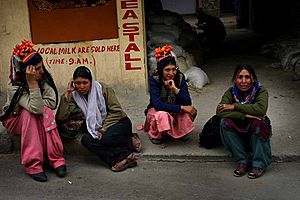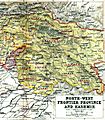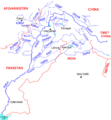Kashmir facts for kids
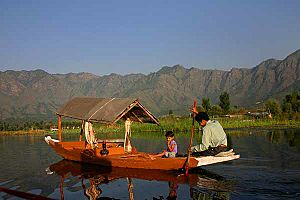
Kashmir is a beautiful region in South Asia. It is known for its stunning valleys, tall mountains, and many rivers. People love Kashmir for its natural beauty and peaceful way of life.
Since 1947, Kashmir has been a place of disagreement between India, Pakistan, and China. Each country controls a part of the region. India controls about 43% of the land, Pakistan controls about 37%, and China controls the rest. Because of these disagreements, Kashmir is one of the most heavily guarded areas in the world.
Contents
History of Kashmir's Disputed Land
The disagreements over Kashmir started when India and Pakistan became independent countries in 1947. At that time, the ruler of Jammu and Kashmir, Hari Singh, wanted his state to be independent.
However, in October 1947, groups supported by Pakistan entered Kashmir. Hari Singh asked India for help. India agreed, but only if he joined Jammu and Kashmir with India. After he signed the agreement, Indian soldiers arrived to help.
Pakistan said that Hari Singh's decision was not fair, and this led to the First Kashmir War. India took the issue to the United Nations. The UN asked Pakistan to leave the areas it had entered and suggested a vote (called a plebiscite) to let the people decide their future. Pakistan did not leave, so the vote never happened.
India and Pakistan have fought several wars over Kashmir. In 1949 and 1972, they agreed on a border for most of the area. This border between India and Pakistan is called the Line of Control. Soldiers from both countries guard it.
The border between the part of Kashmir controlled by China (called Aksai Chin) and the part controlled by India is known as the Line of Actual Control.
Most people in Kashmir, about 78%, are Muslims.
Kashmir's Economy and Resources
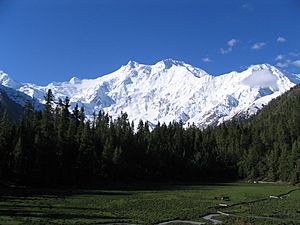
Kashmir's economy mostly depends on agriculture. The main food crop grown in the valley is rice. Farmers also grow corn, wheat, barley, and oats. Because of its mild weather, Kashmir is also good for growing vegetables like asparagus, cauliflower, and cabbage.
Fruit trees are very common. Orchards produce delicious pears, apples, peaches, and cherries. Important trees in the region include deodar, firs, pines, and walnut trees.
Historically, Kashmir was famous worldwide for its Cashmere wool. This special wool came from cashmere goats. Kashmiris are also skilled at making Pashmina Shawls, silk carpets, and Pottery. Saffron, a valuable spice, is also grown here.
In 2005, a big earthquake caused a lot of damage to the economy and sadly, many lives were lost.
The part of Kashmir controlled by India is thought to have rich rocks that might contain oil and gas.
Tourism in Kashmir
Tourism has been very important to Kashmir for many years. Many people call the region Paradise on Earth because of its stunning natural beauty. Tourists from all over the world used to visit Kashmir.
In recent years, fewer people have visited due to safety concerns. However, Kashmir still remains a very popular place for tourists to visit.
Images for kids
-
Political map of the Kashmir region, showing the Pir Panjal Range and the Kashmir Valley.
-
Map of India in 1823, showing the territories of the Sikh Empire including Kashmir.
-
Topographic map of Kashmir.
-
K2, the second highest mountain in the world, located in the Karakoram range.
See also
 In Spanish: Cachemira (región) para niños
In Spanish: Cachemira (región) para niños



